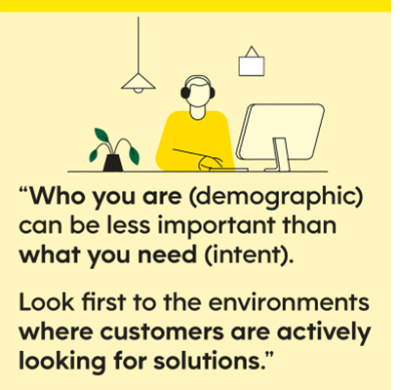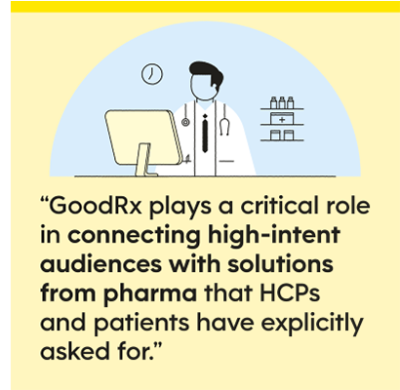Way back in 2015 a post on the Think with Google blog made the bold claim that, for marketers, consumer intent is more powerful than demographics: “Intent beats identity. Immediacy trumps loyalty…. When a need arises, people turn to search and YouTube to look for answers, discover new things, and make decisions. We call these intent-filled moments…. And they're the best opportunity marketers have to connect with people at the exact moment they are looking for something.”1 The post closed with two simple elements for success: In the moments that customers are looking for help—be there and be useful.
In 2023 marketers still consider intent, although current discussions are underpinned by newer technologies and more data, and are therefore more nuanced. At a recent health media event, Ryan Sullivan, SVP Marketing & Monetization at GoodRx, sat down with Cozi Namer, Senior Director of Strategic Initiatives at Pfizer, to consider the characteristics and roles of high-intent platforms in healthcare. What follows are some themes distilled from their lively discussion. Click here to learn more about how GoodRx can help your brand reach high-intent HCP and consumer audiences.
Characteristics that make a platform ‘high intent’

Three characteristics make action oriented, high-intent platforms more valuable to marketers than those used for reference or ‘window shopping.’ First, they tend to have high trust, such as a brand like GoodRx that people know and actively seek when they have a specific need. Users discover or are referred to these platforms and thereafter seek them out again and again as their needs evolve.
Second, user engagement with a high-intent platform generates valuable zero-party data focused on wants and needs and not simple identity cues like demographics. Forrester Research defines zero-party data as “that which a customer intentionally and proactively shares with a brand. It can include preference center data, purchase intentions, personal context, and how the individual wants the brand to recognize them.”2
Lastly, a high-intent platform is designed and built to solve a fundamental industry need, and its business model is often tied to its core purpose. For example, while price-comparison tools were common in other industries, GoodRx created an entirely new access point for customers to research and compare retail prescription pricing for prescription medications across pharmacies—and its subsequent revenue streams came only after fulfilling its core mission. GoodRx is first and foremost a prescription savings platform, and the trust it has built with its audiences is what enables relevant, high-impact pharma advertising and savings integrations that align with its purpose.
The fuel for high-intent platforms is data
“Marketing is a data play. Engagement requires measurement every day, questioning every single activation you do, because you know quickly whether you’re achieving your goals,“ Namer said. Traditional awareness advertising requires matching your budget to your reach goals. However, “the bar is a bit higher when your goal is to enable the right person to complete their intended action.”
Sullivan also talked about the role of data: “We’ve found that the audiences we reach are ready and motivated to do something, and actively seek solutions to their problems.” Data helps not only those who build high-intent platforms to continuously improve them, but also marketers who partner with these platforms to take advantage of engaging someone contextually when they’re in an action mindset.
Namer added that data were integral to evolving these platforms to stay relevant and useful. As an example, he provided insight into the development of Pfizer’s VaxAssist platform that helps patients determine vaccine eligibility, find locations where vaccines are given, and book appointments. Namer pointed out that data is not a stifler, but a liberator. “Using data may be the only way you can say ‘No,’” he mused. “With data you can have the confidence to say, ‘I like your idea—but other people don't. And here’s the research.’”
High-intent platforms can create new opportunities for pharma

So, why do high-intent platforms in healthcare seem to be gaining momentum? One reason is that talent joining pharma from other industries has accelerated innovation by bringing with them the knowledge, experience, and capabilities that have already worked outside of healthcare, such as user-based, iterative software development. In addition, pharma marketers and their agencies can more easily combine decades of longitudinal data with real-time behavioral insights. Finally, patient and provider expectations of healthcare companies have been raised forever by their positive, digital-first experiences with consumer-focused innovators like Apple and Amazon.
There are numerous opportunities for the pharmaceutical industry to leverage high-intent platforms for education and promotion of products and services to providers and patients. According to Sullivan, “Who you are (demographic) can be less important than what you need (intent). Businesses of all kinds, and especially in pharma, need to look first to the environments where customers are actively looking for solutions. Then they can layer on additional sources of insight.”
There are a growing number of new digital platforms available to, and built by, pharma that lean heavily on patient and provider intent—their needs expressed through action and engagement. Namer said that “intent gives you permission to ask more, but it also is a commitment to provide value as well. If you don't fulfill that promise, you don't have the right to ask more questions.”
GoodRx connects providers, patients, and pharma

Sullivan said that in its early days GoodRx was focused on savings for generic drugs. However, in analyzing their platform data they discovered a high number of searches for branded prescription medications. Based on this insight GoodRx enhanced its capability to “direct users to appropriate pharma copay, access, and patient support programs, vaccine finders like VaxAssist, and other resources sought by users,” he said.
And even though the platform was initially designed and built to deliver savings to consumers, GoodRx researchers observed that many providers were also using the platform and understood there was an enormous opportunity to create innovative products to serve their unique needs and better capture their attention when in a prescribing mindset. HCPs use GoodRx as a tool in the workplace, not a journal for reading on the couch.
Sullivan closed the conversation with his perspective on GoodRx as a high-intent platform that benefits providers, patients, and pharma: “In addition to our high trust with providers and consumers, part of GoodRx’s value to pharma companies and their brands is that they don’t need to interrupt HCPs and patients when they are on other websites and perhaps not in a healthcare frame of mind.” Sullivan concluded, “GoodRx plays a critical role in connecting high-intent audiences with solutions from pharma that HCPs and patients have explicitly asked for.”
Click here to learn more about how GoodRx can help your brand reach high-intent HCP and consumer audiences.
1 Lisa Gevelber, “Why consumer intent is more powerful than demographics,” Think with Google, December 2015.
https://www.thinkwithgoogle.com/consumer-insights/consumer-trends/why-consumer-intent-more-powerful-than-demographics/
2 Fatemeh Khatibloo, et al. “Q&A: What Marketers Need To Know About Zero-Party Data,” Forrester.com, October 10, 2018. https://www.forrester.com/report/QA-What-Marketers-Need-To-Know-About-ZeroParty-Data/RES145095